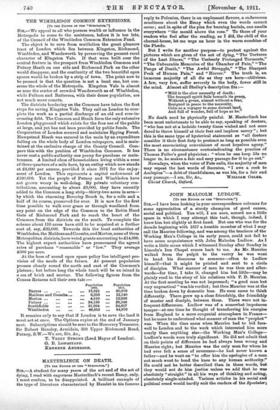THE WIMBLEDON COMMON EXTENSIONS.
[To THE EDITOR OP THE "SPECTATOR."] SIR,—We appeal to all who possess wealth or influence in the Metropolis to come to the assistance, before it is too late, of the Council of the Wimbledon Common Extension Fund.
The object is to save from mutilation the great pleasure tract of London which lies between Kingston, Richmond, Wimbledon, and Wandsworth by preserving the present rural character of Kingston Vale. If that were built over the central feature in the prospect from Wimbledon Common and Putney Heath on one side and Richmond Park on the other would disappear, and the continuity of the two beautiful open spaces would be broken by a strip of town. The point now to be pressed is that the question is not a local one, but con- cerns the whole of the Metropolis. Kingston Vale is almost as near the centre of crowded Wandsworth as of Wimbledon, while Fulham and Battersea, with their dense population, are not much more remote.
The districts bordering on the Common have taken the first steps for saving Kingston Vale. They call on London to com- plete the work as a partial discharge of an old and ever-in- creasing debt. The Common and Heath form the only extensive London playground which exists for the free use of the public at large, and yet has not been provided by public funds. The Corporation of London secured and maintains Epping Forest. Hampstead Heath was secured in the main by an expenditure falling on the whole body of London ratepayers, and is main- tained at the exclusive charge of the County Council. Com- pare this with the position of Wimbledon Common. It has never cost a public authority one penny for purchase or main- tenance. A limited class of householders living within a zone of three-quarters of a mile have, by an outlay which now stands at £4,000 per annum, provided it since 1871 for the enjoy- ment of London. This represents a capital endowment of £100,000. Yet the people of Putney and Wimbledon have not grown weary in well-doing. By private voluntary con- tributions, amounting to about £9,000, they have recently added to the Common a long strip—thirty-two acres in area— by which the charming Beverley Brook is, for a mile and a half of its course, preserved for ever. It is now for the first time possible to walk over grass or through woodland from any point on the edge of the Common to the Robin Hood Gate of Richmond Park and to reach the heart of the Common from the districts on the south. To complete the scheme about 110 acres have still to be acquired at a further cost of, say, £35,000. Towards this the local authorities of Wimbledon, the Maidens and Coombe, and Merton, none of them Metropolitan districts, have voted grants amounting to £14,000. The highest expert authorities have pronounced the agreed rates of purchase " reasonable " or " low." They average £306 per acre.
At the base of sound open space policy lies intelligent pro- vision of the needs of the future. At present population presses closely round the north and east of the Common's plateau ; but before long the whole track will be an island in a sea of brick and mortar. The following figures from the Census Returns tell their own tale :- Population
1901.
Population 1911.
Barnes ... ... ...
... 17,821
•••
80,379 Maidens and Coombe ... ... 6,233
•••
12,140
Merton ... ... ...
... 4,510
•••
12,938
Putney ... ... ...
... 24,139
•••
28,246 Southfields ... ... ... 21,924
es.
34,607 Wimbledon ... ... ... 48,652
• ••
54,876 It remains only to say that if London is to save the land it must act at once. The Options expire at the end of January next. Subscriptions should be sent to the Honorary Treasurer, Sir Robert Hensley, Armidale, 309 Upper Richmond Road, Putney, S.W.—We are, Sir, &c.,
T. VEZEY STRONG (Lord Mayor of London). G. B. LONGSTAFF.
KENNETH ANDERSON.






































































 Previous page
Previous page